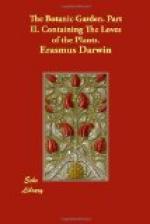[Byssus. 437. Clandestine Marriage. It floats on the sea in the day, and sinks a little during the night; it is found in caverns on the northern shores, of a pale green colour, and as thin as paper.]
Where
cool’d by rills, and curtain’d round by
woods,
Slopes
the green dell to meet the briny floods,
445 The sparkling noon-beams trembling on the tide,
The
PROTEUS-LOVER woos his playful bride,
To
win the fair he tries a thousand forms,
Basks
on the sands, or gambols in the storms.
A
Dolphin now, his scaly sides he laves,
450 And bears the sportive damsel on the waves;
She
strikes the cymbal as he moves along,
And
wondering Ocean listens to the song.
—And
now a spotted Pard the lover stalks,
Plays
round her steps, and guards her favour’d walks;
[The Proteus-love. l. 446. Conserva polymorpha. This vegetable is put amongst the cryptogamia, or clandestine marriages, by Linneus; but, according to Mr. Ellis, the males and females are on different plants. Philos. Trans. Vol. LVII. It twice changes its colour, from red to brown, and then to black; and changes its form by losing its lower leaves, and elongating some of the upper ones, so as to be mistaken by the unskilful for different plants. It grows on the shores of this country.
There is another plant, Medicago polymorpha, which may be said to assume a great variety of shapes; as the seed-vessels resemble sometimes snail-horns, at other times caterpillars with or without long hair upon them; by which means it is probable they sometimes elude the depredations of those insects. The seeds of Calendula, Marygold, bend up like a hairy caterpillar, with their prickles bridling outwards, and may thus deter some birds or insects from preying upon them. Salicornia also assumes an animal similitude. Phil. Bot. p. 87. See note on Iris in additional notes; and Cypripedia in Vol. I.]
455 As with white teeth he prints her hand, caress’d,
And
lays his velvet paw upon her breast,
O’er
his round face her snowy fingers strain
The
silken knots, and fit the ribbon-rein.
—And
now a Swan, he spreads his plumy sails,
460 And proudly glides before the fanning gales;
Pleas’d
on the flowery brink with graceful hand
She
waves her floating lover to the land;
Bright
shines his sinuous neck, with crimson beak
He
prints fond kisses on her glowing cheek,
465 Spreads his broad wings, elates his ebon crest,
And
clasps the beauty to his downy breast.
A
hundred virgins join a hundred swains,
And
fond ADONIS leads the sprightly trains;




